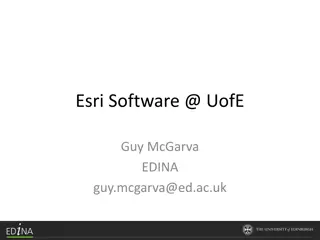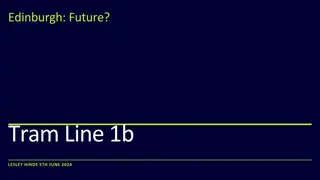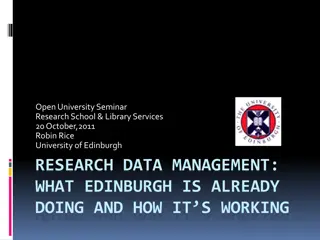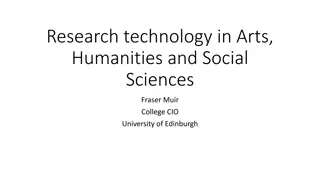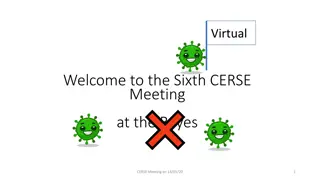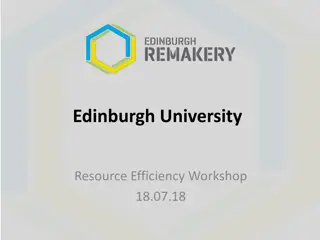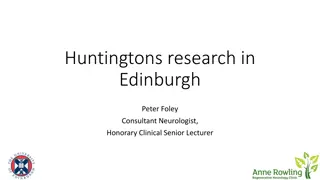
Sparse Models Analysis Using K-SVD Dictionary Learning
Explore K-SVD dictionary learning for analysis of sparse models, covering synthesis representation, pursuit algorithms, dictionary learning, and the K-SVD model. Understand the basics, strategies for sparse coding, and the dictionary update process to enhance signal recovery.
Download Presentation

Please find below an Image/Link to download the presentation.
The content on the website is provided AS IS for your information and personal use only. It may not be sold, licensed, or shared on other websites without obtaining consent from the author. If you encounter any issues during the download, it is possible that the publisher has removed the file from their server.
You are allowed to download the files provided on this website for personal or commercial use, subject to the condition that they are used lawfully. All files are the property of their respective owners.
The content on the website is provided AS IS for your information and personal use only. It may not be sold, licensed, or shared on other websites without obtaining consent from the author.
E N D
Presentation Transcript
K-SVD Dictionary-Learning for Analysis Sparse Models * Michael Elad The Computer Science Department The Technion Israel Institute of technology Haifa 32000, Israel Joint work with Ron Rubinstein and SPARS11 Workshop: Signal Processing with Adaptive Sparse Structured Representations June 27-30, 2011 - Edinburgh, (Scotland, UK) Remi Gribonval, Mark Plumbley, Mike Davies, Sangnam Nam, Boaz Ophir, Nancy Bertin
Part I - Background Recalling the Synthesis Model and the K-SVD K-SVD Dictionary-Learning for Analysis Sparse Models By: Michael Elad 2
The Synthesis Model Basics m The synthesis representation is expected to be sparse: = 0 k d = d Adopting a Bayesian point of view: Dictionary x Draw the support at random D Choose the non-zero coefficients randomly (e.g. iid Gaussians) Multiply by D to get the synthesis signal Such synthesis signals belong to a Union-of-Subspaces (UoS): = T k k = T x span D D x where T T m This union contains subspaces, each of dimension k. K-SVD Dictionary-Learning for Analysis Sparse Models By: Michael Elad 3
The Synthesis Model Pursuit Fundamental problem: Given the noisy measurements, = + = + y x v I 2 D v, v ~ N 0, recover the clean signal x This is a denoising task. = 2 D = = D This can be posed as: x ArgMin y s.t. k 0 2 While this is a (NP-) hard problem, its approximated solution can be obtained by Use L1 instead of L0 (Basis-Pursuit) Greedy methods (MP, OMP, LS-OMP) Pursuit Algorithms Hybrid methods (IHT, SP, CoSaMP) Theoretical studies provide various guarantees for the success of these techniques, typically depending on k and properties of D. K-SVD Dictionary-Learning for Analysis Sparse Models By: Michael Elad 4
The Synthesis Model Dictionary Learning = X D A = j 1 I N = + 2 GivenSignals: y x v v ~ N 0, j j j j N 2 j = Min D A D y s.t. j 1,2, ,N k Field & Olshausen (96 ) Engan et. al. (99 ) j j 0 , 2 = j 1 Each example is a linear combination of atoms from D Each example has a sparse representation with no more than k atoms Gribonval et. al. (04 ) Aharon et. al. (04 ) K-SVD Dictionary-Learning for Analysis Sparse Models By: Michael Elad 5
The Synthesis Model K-SVD Aharon, E., & Bruckstein (`04) Initialize D e.g. choose a subset of the examples Recall: the dictionary update stage in the K-SVD is done one atom at a time, updating it using ONLY those examples who use it, while fixing the non-zero supports. D Sparse Coding Use OMP or BP Y Dictionary Update Column-by-Column by SVD computation K-SVD Dictionary-Learning for Analysis Sparse Models By: Michael Elad 6
Part II - Analysis The Basics of the Analysis Model 1. S. Nam, M.E. Davies, M. Elad, and R. Gribonval, "Co-sparse Analysis Modeling - Uniqueness and Algorithms" , ICASSP, May, 2011. S. Nam, M.E. Davies, M. Elad, and R. Gribonval, "The Co-sparse Analysis Model and Algorithms" , Submitted to ACHA, June 2011. 2. K-SVD Dictionary-Learning for Analysis Sparse Models By: Michael Elad 7
The Analysis Model Basics d The analysis representation z is expected to be sparse = 0 x z = p = 0 Co-sparsity: - the number of zeros in z. p Co-Support: - the rows that are orthogonal to x = x x 0 * z Analysis Dictionary If is in general position , thenand thus we cannot expect to get a truly sparse analysis representation Is this a problem? No! 0 d Notice that in this model we put an emphasis on the zeros in the analysis representation, z, rather then the non-zeros. In particular, the values of the non-zeroes in z are not important to characterize the signal. = + T * spark d 1 K-SVD Dictionary-Learning for Analysis Sparse Models By: Michael Elad 8
The Analysis Model Bayesian View d Analysis signals, just like synthesis ones, can be generated in a systematic way: = Synthesis Signals Analysis Signals p x Support: Choose the support T (|T|=k) at random Choose T at random Choose the co- support (| |= ) at random z Analysis Dictionary Coef. : Choose a random vector v Orhto v w.r.t. : = x I Generate: Synthesize by: DT T=x v = = Bottom line: an analysis signal x satisfies: s.t. x 0 K-SVD Dictionary-Learning for Analysis Sparse Models By: Michael Elad 9
The Analysis Model UoS d Analysis signals, just like synthesis ones, belong to a union of subspaces: = Synthesis Signals Analysis Signals p x What is the Subspace Dimension: k d- Analysis Dictionary How Many Subspaces: m p z k Who are those Subspaces: span span D T Example: p=m=2d: Synthesis: k=1 (one atom) there are 2d subspaces of dimensionality 1 Analysis: =d-1 leads to >>O(2d) subspaces of dimensionality 1 d 1 2d K-SVD Dictionary-Learning for Analysis Sparse Models By: Michael Elad 10
The Analysis Model Pursuit Fundamental problem: Given the noisy measurements, = = + y x v, I = 2 s.t . x 0 , v ~ N 0, recover the clean signal x This is a denoising task. 2 = = p x This goal can be posed as: ArgMin y x s.t. x 0 2 This is a (NP-) hard problem, just as in the synthesis case (and even harder!!!) We can approximate its solution by L1 replacing L0 (BP-analysis) Greedy methods (OMP, ), and Hybrid methods (IHT, SP, CoSaMP, ). Theoretical studies should provide guarantees for the success of these techniques, typically depending on the co-sparsity and properties of . K-SVD Dictionary-Learning for Analysis Sparse Models By: Michael Elad 11
The Analysis Model Backward Greedy BG finds one row at a time from for approximating the solution of 2 = = p x ArgMin y x s.t. x 0 2 Variations and Improvements: Gram-Schmidt applied to the accumulated rows speeds-up the Initialization = T k 1.FindNextRow: k ArgMin w x i 1 i = = = k i 1 i 0, x y = + i i 1 algorithm. An exhaustive alternative, xBG, can be used, where per each candidate row we test the decay in the projection energy and choose the smallest of them as the next row. One could think of a forward alternative that detects the non-zero rows (GAP) talk with Sangnam. 0 2.Update Support: k i 1 i 1 i = 0 and = 3.Project: x I y i i i No Yes i= Stop K-SVD Dictionary-Learning for Analysis Sparse Models By: Michael Elad 12
The Analysis Model Low-Spark What if spark( T)<<d ? Horizontal Derivative For example: a TV-like operator for image- patches of size 6 6 pixels ( size is 72 36) = = Here are analysis-signals generated for co- sparsity ( ) of 32: Vertical Derivative 800 700 600 # of signals 500 Their true co-sparsity is higher see graph: 400 300 d In such a case we may consider 200 100 More info: S. Nam, M.E. Davies, M. Elad, and R. Gribonval 0 0 10 20 30 40 50 60 70 80 Co-Sparsity K-SVD Dictionary-Learning for Analysis Sparse Models By: Michael Elad 13
The Analysis Model Low-Spark Pursuit An example performance of BG (and xBG) for these TV-like signals: 1000 signal examples, SNR=25 BG or xBG x Accuracy of the co-support recovered y Denoising performance 2 E x x 2 2 d E K-SVD Dictionary-Learning for Analysis Sparse Models By: Michael Elad 14
The Analysis Model Summary m The analysis and the synthesis models are similar, and yet very different D = d The two align for p=m=d : non-redundant Just as the synthesis, we should work on: x Pursuit algorithms (of all kinds) Design Pursuit algorithms (of all kinds) Theoretical study d Dictionary learning from example-signals Applications = Our experience on the analysis model: z p Theoretical study is harder x Different applications should be considered K-SVD Dictionary-Learning for Analysis Sparse Models By: Michael Elad 15
Part III Dictionaries Analysis Dictionary-Learning by K-SVD-Like Algorithm 1. B. Ophir, M. Elad, N. Bertin and M.D. Plumbley, "Sequential Minimal Eigenvalues - An Approach to Analysis Dictionary Learning", EUSIPCO, August 2011. R. Rubinstein and M. Elad, "The Co-sparse Analysis Model and Algorithms" , will be submitted (very) soon to IEEE-TSP .... 2. K-SVD Dictionary-Learning for Analysis Sparse Models By: Michael Elad 16
Analysis Dictionary Learning The Signals = X A We are given a set of N contaminated (noisy) analysis signals, and our goal is to recover their analysis dictionary, I N = + = = 2 jy x v , s.t . x 0 , v~ N 0 , j j j j = j j 1 K-SVD Dictionary-Learning for Analysis Sparse Models By: Michael Elad 17
Analysis Dictionary Learning Goal Synthesis N 2 j = Min D A D y s.t. j 1,2, ,N k j j 0 , 2 = j 1 Analysis N 2 = p Min X x y s.t. j 1,2, ,N x j j j 0 , 2 = j 1 We shall adopt a similar approach to the K-SVD for approximating the minimization of the analysis goal K-SVD Dictionary-Learning for Analysis Sparse Models By: Michael Elad 18
Analysis Dictionary Sparse-Coding N 2 = p Min X x y s.t. j 1,2, ,N x j j j 0 , 2 = j 1 Assuming that is fixed, we aim at updating X N 2 = p x ArgMin x y X s.t. x j 0 j2 = j 1 These are N separate analysis-pursuit problems. We suggest to use the BG or the xBG algorithms. K-SVD Dictionary-Learning for Analysis Sparse Models By: Michael Elad 19
Analysis Dictionary Dic. Update (1) N 2 = p Min X Assuming that X has been updated (and thus j are known), we now aim at updating a row (e.g. wkT) from x y s.t. j 1,2, ,N x j j j 0 , 2 = j 1 We use only the signals Sk that are found orthogonal to wk Each example should keep its co-support j\k j S = x 0 j Avoid trivial solution k j 2 = = T k w , Min X Y s.t. w X 0 1 k k k 2 X k k w k2 Each of the chosen examples should be orthogonal to the new row wk K-SVD Dictionary-Learning for Analysis Sparse Models By: Michael Elad 20
Analysis Dictionary Dic. Update (2) j S = x 0 j k j 2 = = T k w , Min X Y s.t. w X 0 1 k k k 2 X k k w k2 This problem we have defined is too hard to handle Intuitively, and in the spirit of the K-SVD, we could suggest the following alternative = = T k w w X 0 1 2 k j w , Min X I Y s.t. k j k X 2 k k k2 K-SVD Dictionary-Learning for Analysis Sparse Models By: Michael Elad 21
Analysis Dictionary Dic. Update (3) = = T k w w X 0 1 2 k j w , Min X I Y s.t. k j k X 2 k k k2 This lacks in one of the forces on wk that the original problem had A better approximation for our original problem is = = T k w w X 0 1 2 = T k 2 k w , Min w Y s.t. w 1 w , Min X k 2 Y s.t. k k k 2 2 X k k k k2 The obtained problem is a simple Rank-1 approximation problem, easily given by SVD K-SVD Dictionary-Learning for Analysis Sparse Models By: Michael Elad 22
Analysis Dictionary Learning Results (1) Synthetic experiment #1: TV-Like We generate 30,000 TV-like signals of the same kind described before ( : 72 36, =32) We apply 300 iterations of the Analysis K-SVD with BG (fixed ), and then 5 more using the xBG Initialization by orthogonal vectors to randomly chosen sets of 35 examples T Additive noise: SNR=25. atom detected if: 1 w w 0.01 100 Relative Recovered Rows [%] Even though we have not identified completely (~92% this time), we got an alternative feasible analysis dictionary with the same number of zeros per example, and a residual error within the noise level. 80 60 40 20 0 0 100 200 300 Iteration K-SVD Dictionary-Learning for Analysis Sparse Models By: Michael Elad 23
Analysis Dictionary Learning Results (1) Synthetic experiment #1: TV-Like Original Analysis Dictionary Learned Analysis Dictionary K-SVD Dictionary-Learning for Analysis Sparse Models By: Michael Elad 24
Analysis Dictionary Learning Results (2) Synthetic experiment #2: Random Very similar to the above, but with a random (full-spark) analysis dictionary : 72 36 Experiment setup and parameters: the very same as above In both algorithms: replacing BG by xBG (in both experiments) leads to a consistent descent in the relative error, and better recovery results. However, the run-time is ~50 times longer 100 Relative Recovered Rows [%] As in the previous example, even though we have not identified completely (~80% this time), we got an alternative feasible analysis dictionary with the same number of zeros per example, and a residual error within the noise level. 80 60 40 20 0 0 100 200 300 Iteration K-SVD Dictionary-Learning for Analysis Sparse Models By: Michael Elad 25
Analysis Dictionary Learning Results (3) Experiment #3: Piece-Wise Constant Image Initial We take 10,000 patches (+noise =5) to train on Here is what we got: Trained (100 iterations) Original Image Patches used for training K-SVD Dictionary-Learning for Analysis Sparse Models By: Michael Elad 26
Analysis Dictionary Learning Results (4) Experiment #3: The Image House Initial We take 10,000 patches (+noise =10) to train on Here is what we got: Trained (100 iterations) Original Image Patches used for training K-SVD Dictionary-Learning for Analysis Sparse Models By: Michael Elad 27
Part IV We Are Done Summary and Conclusions K-SVD Dictionary-Learning for Analysis Sparse Models By: Michael Elad 28
Today We Have Seen that Sparsity and Redundancy are practiced mostly in the context of the synthesis model Yes, the analysis model is a very appealing (and different) alternative, worth looking at Is there any other way? We propose new algorithms (e.g. K- SVD like) for this task. The next step is applications that will benefit from this In the past few years there is a growing interest in better defining this model, suggesting pursuit methods, analyzing them, etc. So, what to do? What about Dictionary learning? More on these (including the slides and the relevant papers) can be found in http://www.cs.technion.ac.il/~elad K-SVD Dictionary-Learning for Analysis Sparse Models By: Michael Elad 29





